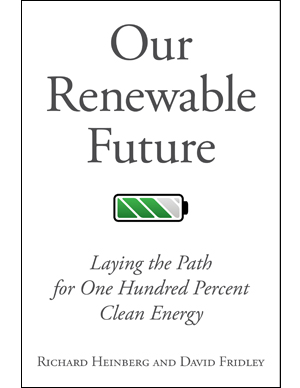What Will it Take to Avert Collapse?
September 21, 2018

A lot of people are asking the question these days—including serious folks who work full-time on climate and energy policy. How can the world’s nations reduce greenhouse gas emissions fast enough to forestall climate catastrophe, without undermining either the global economy (which is still 85 percent dependent on fossil fuels) or the hopes of billions of people in poorer countries to raise their economic prospects through “development”—which historically has depended on increasing per capita energy usage?
The United Nations has passed this vexing question along to the global climate science community as a formal request to write a Special Report providing “feasible” pathways to limit global warming to 1.5 degrees Celsius while supporting economic growth and meeting the UN’s Sustainable Development Goals. The science community has responded by publishing papers featuring scenarios to fit those specifications. Until recently, most scenarios have relied on negative emissions technologies, including CCS (capturing carbon from fossil-fueled power plants, then sequestering it), or BECCS (growing biomass crops, burning them for power, then recapturing the carbon and storing it). Critics have savaged these plans as being too expensive and too environmentally risky.
A major new 13-page paper in Nature Energy, with 122 pages of supplementary materials, takes an entirely different approach. The goal of the authors, led by Arnolf Grubler, was to model a scenario that limits global warming to 1.5 °C while meeting economic goals withoutinvoking negative emission technologies—relying instead on energy demand reduction. We and our colleagues at Post Carbon Institute have for years promoted demand reduction as the primary viable pathway to averting catastrophic climate change. However, we assume that reducing energy usage dramatically would also result in economic contraction; indeed, we don’t see any way to maintain growth much longer as energy from fossil fuels declines—whether due to climate policy or fossil fuel depletion. In our view, one of the main jobs of policy makers these days should be to find ways to minimize the impacts of economic retrenchment.
The authors of the paper are more sanguine; they write:
[W]e show how an appropriate scaling down of the size of the global energy system creates the necessary space for a feasible supply-side decarbonization within a 1.5 °C emission budget without the need for negative emission technologies and with significant sustainable development co-benefits.
We decided to take a close look at this low energy demand scenario to see just how feasible it is. Its assumptions appear transparent and well documented in the Supplemental Materials. However, as we dug into those assumptions, it was clear that the authors envision a nearly complete revamping of technology, institutions, behaviors, and belief systems to achieve their goals, and this societal transformation would need to start immediately.

In the study, much of the assumed transformation is achieved by near-universal digitalization. The authors focus on end-use energy services, suggesting that most of these could be delivered far more efficiently using microelectronics. Household and commercial electricity use could be slashed as multiple pieces of equipment are foregone for a smart phone—whose 5 Watt power consumption would substitute for 450 Watts of consumption from cameras, calculators, TVs, game consoles, DVRs, radios, scanners, tablets, stereos, alarm clocks, GPS, weather stations, video cameras, etc. Some of these uses have already been taken over by smart phones. Moreover, the authors assume that household appliances will all be connected to the Internet of Things, to allow for their optimal operation and seamless availability for demand response.
What’s not mentioned in the Grubler scenario is that universal digitalization would require a robust, dependable electricity supply and electronic communications network. This would entail substantial new infrastructure and electricity demand to accommodate data transmission, storage, and processing for nearly every piece of equipment on Earth. It would also require a great deal of copper. And it would all have to work together seamlessly 24/7.
In their discussion of energy usage in buildings, the authors posit dramatic gains in heating and cooling efficiency through a complete retrofit of buildings in the global North during the study period extending to 2050; indeed, 3 percent of buildings would have to be retrofitted each year. Meanwhile, all new buildings in the global South (amounting cumulatively to 84 billion square meters) would be built to achieve passivhaus construction standards.
“Industry” in the scenario is treated with a focus primarily on six sectors (steel, aluminum, cement, paper, petrochemicals, and feedstocks). Reductions in demand derive from maximum assumptions of dematerialization (needing less stuff) and material efficiency (stuff lasting longer), with all stuff produced at world best-practice efficiency levels. The study assumes a reduction in vehicle stock from a projected one billion in 2050 to 530 million because of the emergence of a sharing economy (more on that below). Altogether the authors project a four-billion-tonne reduction in annual demand for output from the combined six focus sectors in 2050, despite the fact that they accept that population will grow to nine billion people and that the UN’s economic assumptions regarding GDP growth rates and income will be achieved.
It is hard to reconcile the observed long-term close relationships between global GDP and materials/energy use, with the assumption that population and wealth will continue to grow while materials and energy usage will start to shrink. Economists call this disconnection of GDP from energy and material usage “decoupling.” But, as a recent study has shown, claims of past decoupling don’t hold up to scrutiny. So how do the authors of the “low energy demand” paper propose to achieve in the future what has proved so elusive up until now? Partly through a shift to a sharing society, in which we give up personal ownership of cars, tools, and appliances in favor of payment for energy services such as rides, tool use, etc. Sharing will be enabled and promoted by digitalization and the Internet of Things. Not discussed is the fact that anything with a sensor or a circuit board in it becomes much more difficult to repair.
After adding up all the energy savings from end uses, the authors then create an optimized energy system to run it, in which electricity is 60 percent of all final energy usage by 2050, up from 20 percent today. Residential/commercial electrification is easy to envision, but there are few specifics about how electrification could be extended to industry, which is projected to be nearly fossil fuel-free by shortly after 2050.
 As we discussed in our book Our Renewable Future, industrial uses of energy (especially for high-temperature process like cement making) will be difficult to de-carbonize, and such processes figure into nearly all supply chains. The Grubler scenario excludes aviation and shipping from consideration.
As we discussed in our book Our Renewable Future, industrial uses of energy (especially for high-temperature process like cement making) will be difficult to de-carbonize, and such processes figure into nearly all supply chains. The Grubler scenario excludes aviation and shipping from consideration.
In the end, the model “works” only if every assumption is achieved, at scale, and in the needed time frame. And since the retrofitting requirement alone means we need to be working on over a billion square meters of buildings every year to 2050, it needs to start immediately; the institutional, behavioral, social, technological, and other changes necessary must fall into place just as quickly.
The global climate science community has so far supplied scenarios to meet the UN’s criteria by relying on the magic of CCS. Now, following criticism of CCS, the community is contemplating a scenario that will be extremely difficult to implement and that relies instead on the magic of decoupling to deliver desired outcomes.
In our view, at some point scientists and policy makers must begin discussing the one scenario that world leaders seem to want to avoid at all costs, i.e., managed economic contraction. The irony is that this scenario could reliably cut greenhouse gas emissions and is achievable without appeal to magic (CCS or decoupling). Absent forethought and planning, contraction could spell ruin to economies addicted to growth. But with planning and management, communities could relocalize and human needs could be met more simply. Population levels could decrease in deliberate and humane ways.
The world’s leaders have saddled the climate science community with a hopeless task. Climate scientists, after all, have dedicated their careers to studying natural systems and are likely terribly concerned about the impacts of a warmed planet on humanity and other species. Now they are being required to come up with societal responses that are narrowly constrained within the parameters of what governments believe is politically acceptable. If it turns out that what is actually needed to counter the threat of climate change is political poison, what then? Will policy makers listen and redefine what is politically acceptable? And how long might this back-and-forth continue before an effective response to the climate challenge emerges?
Originally posted at Resilience.org.
Image by Tyler Mullins via Unsplash.
Photo by César Couto on Unsplash
